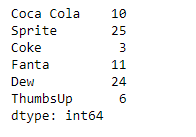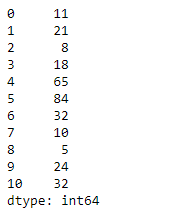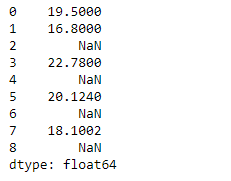Python Pandas Series.tp()
Pandas系列是一个带有轴标签的一维ndarray。标签不需要是唯一的,但必须是一个可散列的类型。该对象支持基于整数和标签的索引,并提供了大量的方法来执行涉及索引的操作。
Pandas Series.ppp()函数返回最大值与以下值之间的差值
对象中的最小值。这相当于numpy.ndarray方法 ptp 。
语法: Series.ptp(axis=None, skipna=None, level=None, numeric_only=None, **kwargs)
参数:
axis:轴,用于函数的应用。
skipna :在计算结果时排除NA/null值。
level : 如果轴是一个MultiIndex(分层),则沿某一层次计数,折叠成一个标量。
numeric_only :只包括浮动、int、boolean列。如果没有,将尝试使用所有数据,然后只使用数字数据。不实现系列。
**kwargs :附加的关键字参数,将被传递给函数。
返回 : ptp : 标量或系列(如果指定级别)。
示例#1:使用Series.tp()函数返回给定Series对象中基础数据的最大值和最小值之间的差异。
# importing pandas as pd
import pandas as pd
# Creating the Series
sr = pd.Series([10, 25, 3, 11, 24, 6])
# Create the Index
index_ = ['Coca Cola', 'Sprite', 'Coke', 'Fanta', 'Dew', 'ThumbsUp']
# set the index
sr.index = index_
# Print the series
print(sr)
输出 :

现在我们将使用Series.tp()函数来寻找给定系列对象中最大和最小值之间的差异。
# return the difference between the
# maximum and the minimum value
result = sr.ptp()
# Print the result
print(result)
输出 :

正如我们在输出中看到的,Series.tp()函数已经成功地返回了给定系列对象中基础数据的最大值和最小值之间的差。
示例#2:使用Series.tp()函数来返回给定Series对象中基础数据的最大值和最小值之间的差。
# importing pandas as pd
import pandas as pd
# Creating the Series
sr = pd.Series([11, 21, 8, 18, 65, 84, 32, 10, 5, 24, 32])
# Print the series
print(sr)
输出 :

现在我们将使用Series.tp()函数来寻找给定系列对象中最大和最小值之间的差异。
# return the difference between the
# maximum and the minimum value
result = sr.ptp()
# Print the result
print(result)
输出 :

正如我们在输出中看到的,Series.tp()函数已经成功地返回了给定系列对象中基础数据的最大值和最小值之间的差。
示例#3:使用Series.tp()函数来返回给定系列对象中基础数据的最大值和最小值之间的差。给定的系列对象中包含一些缺失的值。
# importing pandas as pd
import pandas as pd
# Creating the Series
sr = pd.Series([19.5, 16.8, None, 22.78, None, 20.124, None, 18.1002, None])
# Print the series
print(sr)
输出 :

现在我们将使用Series.tp()函数来寻找给定系列对象中最大和最小值之间的差异。我们将在计算中跳过缺失值。
# return the difference between the
# maximum and the minimum value
result = sr.ptp(skipna = True)
# Print the result
print(result)
输出 :

正如我们在输出中看到的,Series.tp()函数已经成功地返回了给定系列对象中基础数据的最大值和最小值之间的差。
 极客教程
极客教程